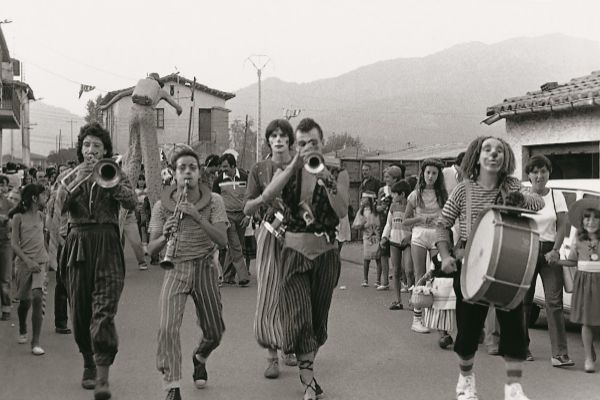- 'Manes' returns. "Society has become more aesthetic and less visceral"
- 'Manes' returns, Carmina Burana, a decade of sins and worldwide success
«La Fura dels Baus is a criminal organization within the current theater scene», says one of the points of the subversive Canalla Manifesto that the theater tribe wrote in 1983, in the image of the movements of the historical avant-garde. In the autumn of that year, they released the embryo of the show that would put them on everyone's lips at the railway crossing of Sitges: Accions . Dressed as executives, young fureros smashed a car with blows of mace and axes. No argument, just sequences. Accions produced a visceral shock to an audience that was not used to such a short distance with the actors. They could feel his sweat, his smell, his breathing.
In those first actions they began to develop, although they were not even aware, their playwright of sensations. "At that time we call it Prehistory," says Àlex Ollé, one of the furero leaders (all are, there are no hierarchies or an André Breton in the group ). A Prehistory that is documented in the book In Quarantine. 40 years of group history: 1979-2019 (Planet), an essay by Mercè Saumell, a doctor in Art History who has followed La Fura since that Action . «In the 80s, some friends told me: 'We are going to see a very rare thing in a building under construction.' I went and it caused an impact that I haven't forgotten yet, ”recalls Saumell.
If something defines La Fura - prehistoric and contemporary - it is the impact. His next work, Suz / o / Suz (1985), was presented in the old morgue of the Galileo street in Madrid: for the first time men appeared eating viscera and drinking wine before facing a battle of flour and blood. «We have never wanted to generate controversies. The controversies have come because we were going against the tide, we were a group with an unusual risk capacity. We are looking for a way to break the spectator's shell, to make it vulnerable, ”explains Ollé. Even in 2002, with La Fura already consolidated worldwide, they dared with a postporno play inspired by the Marquis de Sade. In XXX they mixed images of explicit sex on a large screen with a live vaginal survey. The play produced a real shock in London.
La Fura is the Spanish company that has best staged the aesthetics of cruelty advocated by Artaud. But always with a balance between the popular and the sophisticated, the atavistic and the technological, the corporal and the mechanical prostheses. A will of transgression that has also revolutionized the operatic world. «His greatest contribution to opera has been visually. They have joined the carnality of the present and virtual bodies with hyper-sophisticated projections of almost cinematographic quality. From the beginning, La Fura has known how to discover the performative aspect of digital, ”says Mercè Gatell.
In quarantine, he reviews the biography of Furera through all his shows (and an app that complements the content): the mythical Mediterranean Sea, the Olympic sea that inaugurated the Games of 92, that Manes del 96 that has just been replenished in the Theaters of the Canal and that still causes commotion, La Damnation de Faust (1999) of the Salzburg Festival that would mark a before and after, the show The Man of the Millennium that welcomed the year 2000, his long version of Carmina Burana (2009) or the recent Frankenstein (2019) premiered in Brussels. But in these 40 years there has also been a crisis: the group was on the verge of ruin with the ambitious Naumón project. La Fura bought a 1,100-ton Norwegian cargo ship and adapted it to create syte-specific shows. Between 2004 and 2008 the ship-theater crossed the Mediterranean, the Atlantic and the Pacific. But they could not afford very high maintenance costs and the nautical utopia vanished.
The origin of the Furera utopia - even from its quarantine - dates back to a small Catalan town, Moià, which in the late 1970s barely reached 3,000 inhabitants. Three kids who hadn't even turned 18 -Carlus Padrissa, Pera Tantiñá and Marcel·lí Antúnez- set up the first art exhibition in the region after Franco's death. But the mayor closed it and "kidnapped the works to leave them in quarantine because, according to him, their content was obscene, " Padrissa recalls. The three of Moià left for Barcelona and combined their studies with a car and a mule, with which they traveled the Catalan towns to improvise street theater. It was 1979.
In the countercultural Barcelona they met the rest: Àlex Ollé, Pep Gatell, the rocker Miki Espuma, Jurgen Muller (who came from the then German Federal Republic), Hansel Cereza and Jordi Arús. The nine contributed to pay for a yellow van with which they replaced the car and the mule (today, there are six of the founders). «The group was created at a very specific moment of freedom and experimentation. If we were born in the 21st century, La Fura would not exist. The 21st century is proving a bit disappointing ... », says Miki Espuma. But the utopia furera is very real.
According to the criteria of The Trust Project
Know more- London
- Barcelona
- theater
CultureThe diversity of the zarzuela in 'El caserío' de Guridi
TeatroUn Ricardo III to dissect the corruption of the present
Literature Albert Boadella responds to Cristina Morales: "The people who fan the fire are foolish"

